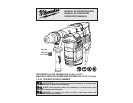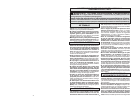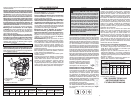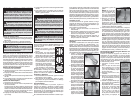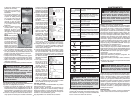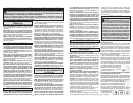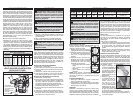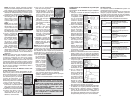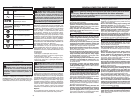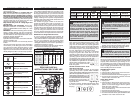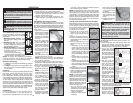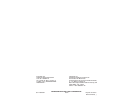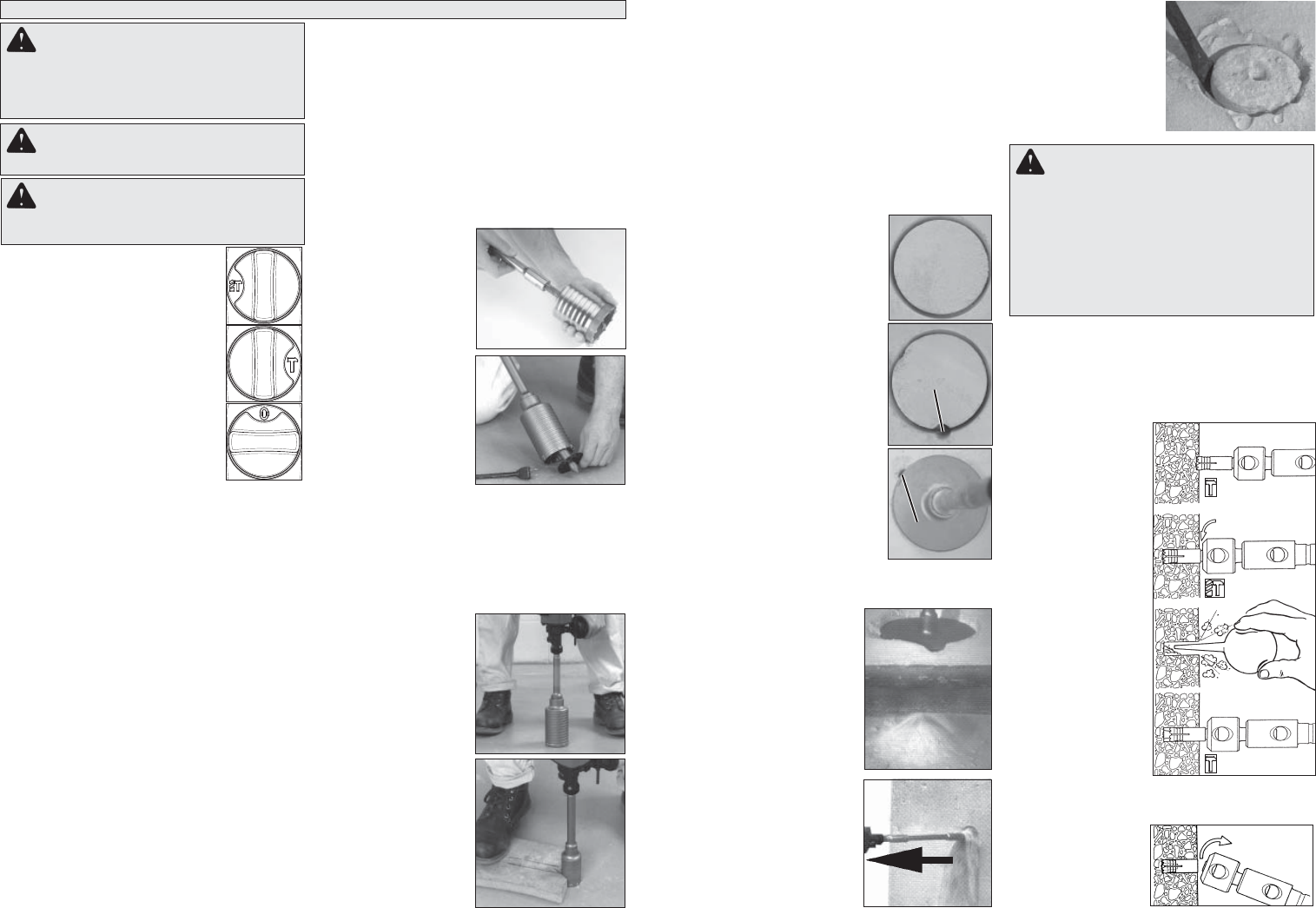
20
21
WARNING To reduce the risk of injury,
keep hands and cord away from the bit and
all moving parts.
Selecting Action
These MILWAUKEE Rotary Hammers
have three settings: hammering with
rotation, hammering-only, and chisel
adjustment.
1. Hammering with rotation. Use
this setting for drilling holes with
drill bits.
2. Hammering only. For use with
“hammering-only” accessories.
Use this setting for chiseling or set-
ting self-drilling anchors.
3. Chisel adjustment. Use this setting
to adjust the angle of the chisel blade
in relation to the tool. With a chisel
mounted in the tool:
• turn the knob to this setting
• rotate the chisel to the desired angle
• turn the knob to "hammering-only".
NOTE: To engage the hammering mechanism,
maintain pressure on the bit. When the pressure
on the bit is released, the hammering will stop.
Starting and Stopping
1. To start the tool, grasp the handle fi rmly and pull
the trigger.
2. To stop the tool, release the trigger. Make sure
the tool comes to a complete stop before laying
the tool down.
Operating
Position the tool, grasp the handles fi rmly and pull
the trigger. Always hold the tool securely using
both handles to maintain control. This tool has
been designed to achieve top performance with
only moderate pressure. Let the tool do the work.
If the speed begins to drop off when drilling large
or deep holes, pull the bit partially out of the hole
while the tool is running to help clear dust. Do not
use water to settle the dust since it will clog the bit
fl utes and tend to make the bit bind in the hole. If
the bit should bind, a built-in, non-adjustable slip
clutch prevents the bit from turning. If this occurs,
stop the tool, free the bit and begin again.
Cold Starting
If this tool is stored for a long period of time or
at cold temperatures, it may not hammer ini-
tially because the lubrication has become stiff.
OPERATION
WARNING To reduce the risk of injury,
wear safety goggles or glasses with side shields.
WARNING To reduce the risk of injury,
always unplug tool before attaching or remov-
ing accessories or making adjustments. Use
only specifi cally recommended accessories.
Others may be hazardous.
To warm up the tool:
1. Insert and lock a bit or chisel into the tool.
2. Pull the trigger and apply force to the bit or chisel
against a concrete or wood surface for a few
seconds. Release the trigger
3. Repeat until the tool starts hammering. The
colder the tool is, the longer it will take to warm
up.
Using Rotary Percussion Core Bits
Core Bits are useful for drilling large or long holes
in concrete. MILWAUKEE Heavy-Duty Core Bits
have heat-treated steel bodies with durable carbide
tips. These core bits are specially designed for fast,
accurate drilling with combined hammering and
rotary action.
1. Clean and lubricate the
threads on the adapter
and core bit to make
later removal easier.
Thread the adapter
shank to the rear of the
core bit.
2. Push the guide plate
onto the pointed end
of the center pin. In-
sert the center pin and
guide plate assembly
into the core bit. Be
sure the small end of
the center pin is se-
curely placed into the
hole in the center of the
core bit.
For LHS systems, screw the threaded end of the
centering bit into the core bit.
NOTE: If using an extension, fi rst thread the
adapter shank to the extension. Then thread the
core bit to the extension.
3. Insert the adapter into the nose of the tool as
described in “Installing Bits and Chisels”. Set the
knob to the "hammering with rotation" setting.
4. Press the centering bit fi rmly against your cen-
ter mark, hold the tool
fi rmly and pull the trig-
ger.
NOTE: If the 48-20-
5099 threaded stud is
used, or a center pin
and guide plate are
not available, use a
template or notched
board to start the hole.
5. Start the tool. After drill-
ing to about the depth
of the core bit teeth,
remove the center pin
and guide plate from
the core bit (not nece-
sary for LHS system).
Resume drilling.
6. To change the core bit,
hold the tool upwards,
pointing it away from
your body, and run it briefl y in forward to loosen
the core bit from the adapter.
NOTE: To make deeper holes, remove the core bit,
break and remove the core, then resume drilling.
When drilling long or deep holes, after each inch
of penetration pull the bit partially out of the hole
while the tool is running, to help clear dust from the
bit fl utes. Dust can clog the bit fl utes and can make
the bit bind in the hole. If this occurs, stop the tool,
free the bit and begin again.
Drilling Large Diameter Holes with Core Bits
When drilling holes with large diameter core bits,
dust may build up in the cut and can cause the tool
to stall, bind, or cut slowly. By creating an opening
for the dust to escape, drilling time, bit stress, and
tool stress can be reduced.
1. Start the cut as normal.
2. Once the bit is fi rmly estab-
lished in the cut (about 1/4"
deep), remove the bit from the
cut.
3. Remove the bit from the tool.
4. Install a standard fluted bit,
approximately 7/8" in diameter,
onto the tool.
5. Drill a perpendicular hole
through the kerf of the large
hole.
• Depending on the location
of the work, the hole should
either break through the
other side of the hole/fl oor
or extend 4"-5" past the end
of the workpiece (such as
into the dirt below a concrete
slab).
• If dust builds up in the hole,
vacuum it out and continue
drilling.
• If drilling through a wall, the
hole for dust should be drilled on the lowest
part of the large hole kerf as the dust will fall
there when drilling and can be evacuated more
easily.
6. Reinstall the core bit and
continue drilling. Dust and
debris will fall through the
hole and optimize the cut-
ting ability of the bit.
NOTE: If unable to drill a hole
in the kerf, pull back on the
bit with the hammer running.
This will remove some of the
dust and debris from the cut.
Repeat this for every inch of
drilling. If necessary, vacuum
dust and debris from the cut
and surrounding area.
7. For core bits, once the
maximum core bit depth
is drilled, the core must be
broken and removed.
• Install a chisel bit.
• Place the chisel into the
hole kerf.
Cut
approximately
1/4" deep with
a core bit.
Drill a hole
through the
work.
Dust and debris
will fall through
the hole.
Top view
Side view
of slab
Pull bit out as far
as possible once
or twice per inch
drilled.
• Chisel down into the
kerf at several points
until the core is loose
or broken.
• Remove the core and
vacuum/remove any
remaining dust and
debris.
• Install the core bit and
continue the cut.
WARNING To reduce the risk of
personal injury and damage to the tool or
work:
• Always use the “hammering-only” setting to
set the anchor. Never use the “hammering-
with-rotation” setting to set the anchor.
• Never switch the tool to “hammering-with-
rotation” until after the anchor has been
set and the tooth anchor chuck has been
removed from the anchor.
Setting Self-Drilling Anchors
MILWAUKEE Tooth Anchor Chucks require a “B”
taper adapter.
1. Place the proper size tooth anchor chuck into
the “B” taper adapter. Then insert the “B” taper
adapter into the tool and lock it into place as
described. See “Installing Bits and Chisels”.
2. Insert the anchor
into the tooth anchor
chuck. Set the knob
for hammering only.
Set the anchor on
your mark and ham-
mer until the teeth
have penetrated the
concrete.
3. Set the knob for
hammering with ro-
tation and drill until
the chuck is 1/8"
above the concrete.
NOTE: It may be
necessary to clean
dust and cuttings
from the anchor sev-
eral times while drill-
ing the hole.
4. Remove the anchor
from the hole while
the tool is running.
Clean the dust and
cuttings from the
anchor by pointing it
downward and turning the tool on and off sev-
eral times. Clean the dust out of the hole with a
vacuum cleaner or blowout bulb.
5. Place the expansion
plug into the anchor
and insert the an-
chor into the hole.
Switch the knob
back to hammering
1/8"



